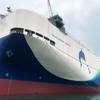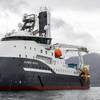Poland boasts a varied and capable ship and boat building and repair base, a core of shipyards and marine equipment suppliers tested and proven to provide advanced marine solutions for owners both domestic and foreign. The companies, which constitute the Polish marine industry, are not unlike their colleagues from around the globe, in that the market forces of consolidation and competition continue to shape and re-shape the industry today. A sign of arrival was seen earlier this year, when Stocznia Gdynia was one of the more active participants in the push to purchase Kvaerner's two high-valued Masa-Yards facilities in Finland, and its announcement of an impending Initial Public Offering. The following serves as an update on Polish marine activities.
Stocznia Gdynia Preps For Mid-2000 IPO
Poland's biggest shipyard Stocznia Gdynia plans to list on the Warsaw and London exchanges next June and invest its IPO proceeds in further developments. In business since the early 1950s, the shipyard has built more than 500 ships comprising more than seven million tons.
Gdynia, that has in past months been an active participant in the potential purchase of Finland's Masa-Yards, is owned by its management and employees, the state treasury and several minority shareholders. Last year Gdynia, the world's fourth biggest maker of container vessels, bought the neighboring bankrupt Gdansk shipyard.
With the IPO and the ensuing cash flow, the company will be in a more favorable position for expansion, either organically or through acquisition, and plans on bolstering its internal logistical system, which allows the firm to cooperate with 800 suppliers in order to gain new contracts. The listing is seen by the yard as also bolstering its image and reputation among its customers and the banks.
As of early autumn, Gdynia, located on Poland's Baltic Sea coast, has signed agreements to build 61 ships worth $2.2 billion through 2003. Gdynia provides vessels that carry chemicals, gas and cars, as well as container ships.
Stocznia Gdynia entered this year with the ambitious plan of increasing ship sales by 40 percent to $570 million through the delivery of 25 vessels. In the midst of its restructuring program initiated several years ago, the company is also reportedly making plans to acquire Poland's Polnocna shipyard, as well as to buy jointly a majority stake in ship engine maker H. Cegielski with smaller Szczecin shipyard and other partners.
Nauta Nears 75
The history of the Shiprepair Yard Nauta — which will turn 75 next year — goes back to early twenties and it is linked with construction of the seaport at Gdynia. It was obvious that the port could not exist without a workshop capable to carry repairs and to build small vessels needed to run a port.
The first workshop was established in 1922 but the name Nauta came to light in 1926, afterwards it disappeared, but this year is recognized as the beginning of Nauta.
The important date in the yard's history was in 1954 when the first floating dock of 1,200 tons lifting capacity was installed. Further development was marked with further lifting facilities: 1966 — dock 3,500 tons; 1979 — dock 4,500 tons; and in 1993 elevator 600 tons.
Naturally those new facilities have not been the only factor in the shipyard's journey to become a diverse and efficient production facility, capable of accepting complicated jobs and completing them to a world-class technical standard. While it is efficient in any specter of work, the yard has a strong presence on the technically challenging end, particularly in bigger ships and lengthenings and conversions.
An example of this is the conversion of the British salvage vessel Challenger — originally in service for the British nuclear submarines — to a unique ship for excavation of diamonds from the sea bed.
Under its new name Ya Toivo, the vessel left the shipyard as the biggest and the most modern ship of its kind in the world. It was lengthened from 443 to 482 ft. (135 to 147 m) and widened from 59 to 79 ft. (18 to 24 m). The entire structure was strengthened and the internal part was completely modernized.
The yard keeps prices competitive by employing a skilled yet flexible workforce of 870, 320 of which are employed by outside suppliers.
One of those companies the Velasalen Nauta Shipyard Ltd., possesses a specific status of a joint venture company with the Icelandic partner. Establishment of Velasalen derives from Nauta's orientation and expansion on Icelandic markets in the field of conversions of fishing vessels. In that area the Icelandic owners became main customers. Up to now more than 50 trawlers were modernized or restructured for Icelandic fishermen. Recently Nauta extended its activity on Dutch, Italian, and French markets with a wide offer of building tugs, barges and dredgers. The overall balance shows that export is increasing steadily and in 1999 it represented 90 percent of revenues. About 70 percent of revenues originated from conversions and newbuildings, with the remaining 30 percent coming from ship repairs.
While the yard has enjoyed a successful history, it is quickly entering a vibrant future with the planned modernization and its eventual privatization.
The first step to privatization — transformation from the state owned enterprise into the joint stock company — has been already completed. The next step is complete privatization, which will result in a reduction of employment with a parallel increase in production and services by about 50 percent. To achieve these goals, management is currently mulling several options, on of which is consolidation with the Naval Shipyard Gdynia.
Cenal Launches Stern Trawler
Cenal Shipyard in August launched the hull of the fishing vessel — stern trawler — measuring 126 ft. (38.3 m) with a beam of 34 ft. (10.5 m). The vessel, which has been built according to DNV rules and regulations, has been approved for class notation DnV X1A1- Fishing Vessel Ice C. Approximately 416-tons, the hull was side launched on August 18 for Karstensens Skibsvaerft A/S. After voyage preparation, the vessel, which boasts main engines by MAN B&W, will be towed to Karstensens for outfitting and commissioning. The launching of two additional fishing vessels from the yard was executed in the same month.
Northern Shipyards Posts Profit
1999 was a profitable year for Northern Shipyard, not a claim many shipyards around the world can make. In all, the builder delivered 10 ships to foreign customers, including two partially outfitted trawlers and 105 ft. (32 m) tug hulls. As has become the custom around the world, Northern has established close working partnerships with some of its fellow national yards, and to this end delivered last July a multipurpose logistics support ship for Euroafrica Shipping Lines. As evidence that the yard is capable of delivering fully outfitted ships, it is building — with Gdansk Shiprepair Yard Remontowa (GSR) — a car-passenger ferry of its B590 design for a demanding Norwegian ship owner.
Featured videos

Inside the Electrified Truckable Tug

Tracking Foreign Vessels Working in the U.S. Jones Act Market

Inmarsat Enhances Service to Drive Digitalization
Subscribe for
Maritime Reporter E-News
Maritime Reporter E-News is the maritime industry's largest circulation and most authoritative ENews Service, delivered to your Email five times per week









